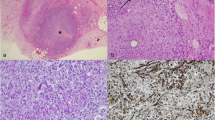Abstract
Mycelial basidiomycetes rarely produce mycoses in animals including humans. We report a case of a 9-year-old female mongrel dog with lesions in the prescapular lymph nodes. The histopathology of a lymph node sample showed flexuous septate hyphae, and a sterile mold grew in culture from that specimen. DNA sequencing of the ITS region allowed us to identify the fungus as Tropicoporus tropicalis. The dog was treated with itraconazole, but it was euthanized six months later due to an unfavorable clinical outcome. Tropicoporus tropicalis is an infrequent pathogen of pets, and the use of molecular tools is needed for its identification. Animal infections due to T. tropicalis were not previously been reported in Argentina.


Similar content being viewed by others
References
Wagner T, Fischer M. Proceedings towards a natural classification of the worldwide taxa Phellinuss. L. and Inonotuss. L. and phylogenetic relationships of allied genera. Mycologia. 2002;94(6):998–1016.
Chowdhary A, Kathuria S, Agarwal K, Meis JF. Recognizing filamentous basidiomycetes as agents of human disease: a review. Med Mycol. 2014;52:782–97.
Sutton DA, Thompson EH, Rinaldi MG, Iwen PC, Nakasone KK, Jung HS, Rosenblatt HM, Paul ME. Identification and first report of Inonotus (Phellinus) tropicalis as an etiologic agent in a patient with chronic granulomatous disease. J Clin Microbiol. 2005;43(2):982–7.
Davis CM, Noroski LM, Dishop MK, Sutton DA, Braverman RM, Paul ME, Rosenblatt HM. Basidiomycetous fungal Inonotus tropicalis sacral osteomyelitis in X-linked chronic granulomatous disease. Pediatr Infect Dis J. 2007;26(7):655–6.
Ramesh M, Resnick E, Hui Y, Maglione PJ, Mehta H, Kattan J, Bouvier NM, La Bombardi V, Victor TR, Chaturvedi S, Cunningham-Rundles C. Phellinus tropicalis abscesses in a patient with chronic granulomatous disease. J ClinImmunol. 2014;34(2):130–3.
Ribas T, Pipe-Martin H, Kim KS, Leissinger MK, Bauer RW, Grasperge BJ, Grooters AM, Sutton DA, Pariaut R. Fungal myocarditis and pericardial effusion secondary to Inonotus tropicalis (phylum Basidiomycota) in a dog. J Vet Cardiol. 2015;17(2):142–8.
Sheppard BJ, McGrath E, Giuffrida M, Craft SL, Kung CY, Smith ME. Report of wood decay fungus Inonotus tropicalis (phylum Basidiomycota) from a dog with a granulomatous mediastinal mass. J Vet Diagn Invest. 2013;25(5):566–72.
Refojo N, Minervini P, Hevia AI, Abrantes RA, Fernández J, Apestey N, Garnero M, Villada M, Davel G. Keratitis caused by moulds in Santa Lucía Ophthalmology Hospital in Buenos Aires. Argentina. Rev IberoamMicol. 2016;33:1–6.
Hasegawa M, Kishino H, Yano T. Dating the human-ape split by a molecular clock of mitochondrial DNA. J MolEvol. 1985;22:160–74.
Nylander JAA. Mr model test v2. Program distributed by the author. Evolutionary Biology Centre: Uppsala University, Uppsala; 2004.
Tamura K, Stecher G, Peterson D, Filipski A, Kumar S. MEGA6: Molecular evolutionary genetics analysis version. Mol Biol Evol. 2013;30(12):2725–9.
Kligman AM. A basidiomycete probably causing onychomycosis. J InvestDermatol. 1950;14(1):67–70.
Salvador Montoya CA, Costa Rezende DH. Tropicoporus drechsleri (Hymenochaetales, Basidiomycota), a new species in the “Inonotus linteus” complex from northern Argentina. Phytotaxa. 2018;338(1):75–89.
Williamson D, Pandey S, Taylor S, Rogers K, Storey L, Marshall MR, Holland D. A case of infection caused by the basidiomycete Phellinus undulatus. J Med Microbiol. 2011;60:256–8.
Bouchara JP, Chaturvedi V. The curious case of "case report" of infections caused by human and animal fungal pathogens: an educational tool, an online archive, or a format in need of retooling. Mycopathologia. 2018;183(6):879–91.
Author information
Authors and Affiliations
Contributions
AH, JF, RS-A, RA, AT and NR have contributed in data acquisition, performing histological and molecular techniques and drafting the manuscript. Both JL and RI are the veterinary doctors who treated the dog reported in this clinical case and analyzed its biological samples. CC conceived the idea and contributed in drafting and finalizing the manuscript.
Corresponding author
Ethics declarations
Conflict of interest
The authors declared that they have no conflict of interest.
Additional information
Publisher's Note
Springer Nature remains neutral with regard to jurisdictional claims in published maps and institutional affiliations.
Handling Editor: Rui Kano.
Electronic Supplementary Material
Below is the link to the electronic supplementary material.
Rights and permissions
About this article
Cite this article
Hevia, A., Iachini, R., Fernández, J. et al. Mycosis Due to Tropicoporus tropicalis (= Inonotus tropicalis) in a Domestic Dog. Mycopathologia 184, 701–706 (2019). https://doi.org/10.1007/s11046-019-00368-1
Received:
Accepted:
Published:
Issue Date:
DOI: https://doi.org/10.1007/s11046-019-00368-1




